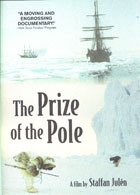
The Prize of the Pole. A Film by Staffan Julen 2006
Distributed by First Run/Icarus Films, 32 Court St., 21st Floor, Brooklyn, NY 11201; 800-876-1710
Produced by Haslund film/Eden film
Directed by Staffan Julen
DVD, color and b & w, 78 min.
College - Adult
Native American Studies, Anthropology, Sociology, History
Date Entered: 12/03/2007
ALA Notable: ALA.gif
Reviewed by Charles Burkart, Media Bibliographer, West Virginia University, Morgantown, WV
The Prize on the Pole is a documentary that recounts the parallel histories of Inuit hunter Hivshu, the great grandson of Arctic explorer Robert Peary, and Minik the sole survivor of six Eskimos that Perry brought to the American Museum of Natural History in New York City for a living anthropological exhibit.
Both intrigued and troubled by stories from tribal elders about his great-grandfather and Minik, one of the six Eskimos (Inuit) brought to New York, later orphaned and adopted by the American Wallace family, Hivshu travels to New York City to try to separate truth from family fantasy. While in New York Hivshu meets with officials from the American Museum of Natural History, The Explorers Club, local residents, as well as librarians and historical archivists.
Much of what Hivshu discovers is deeply troubling. Robert Peary and the anthropological establishment of Franz Boaz viewed the Eskimos as primitive men (living fossils) stuck at an earlier stage of societal development. They were obsessed with the preservation of Eskimo skeletons and brains, and frequently behaved in an unethical manner to obtain them. Hivshu must come to terms with the darker side of his legendary great-grandfather.
The Prize on the Pole combines history and biography with the use of rare archival photographs, audio recordings and motion picture excerpts to chronicle the lives of both Robert Perry and the six Eskimos he brought to the museum. Juxtaposed with this documentary is the personal journey of Hivshu (Robert E. Peary II) examined in a frequently amusing road movie format. Graphics and editing are first rate throughout the movie. The documentary was never boring and transitions between scenes were unobtrusive and natural. Color was vivid and the sound was always clear. Inuit subtitles were easy to read and used appropriately.
This documentary film has won several International awards (2007 Amnesty Award Copenhagen International Documentary Film Festival). It is a valuable addition to college anthropology and Native American Studies departments and libraries. It is highly and enthusiastically recommended.